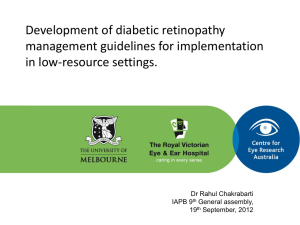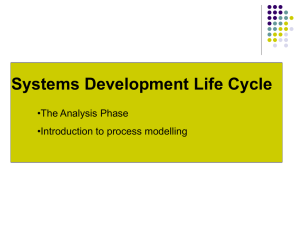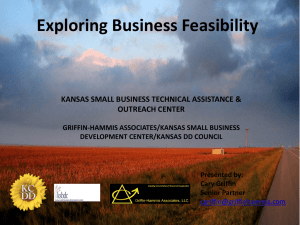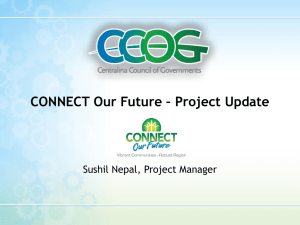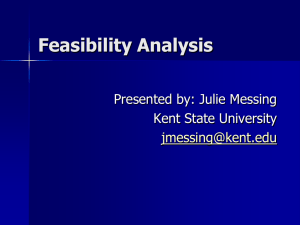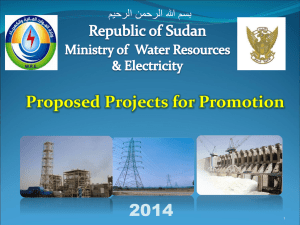Green Infrastructure & Adaptive Management Presentation
advertisement
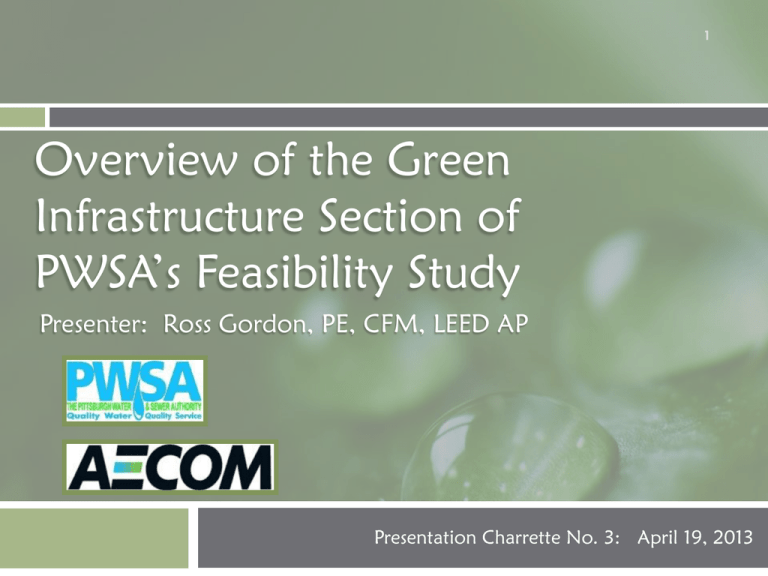
1 Overview of the Green Infrastructure Section of PWSA’s Feasibility Study Presenter: Ross Gordon, PE, CFM, LEED AP Presentation Charrette No. 3: April 19, 2013 Recap – WW Feasibility Study 2 PWSA and City of Pittsburgh Consent Order and Agreement (COA) Entered January 29, 2004 Department of Environmental Protection (DEP) Allegheny County Health Department (ACHD) Requirement per COA Section 15. Paragraph d. Submit Feasibility Study (FS) within 6 months after ALCOSAN submits a Wet Weather Plan (WWP) Recap – Timeline 3 2002 2007 2008 2009 2012 January 2013 PWSA Long ALCOSAN PWSA PWSA modeling PWSA Draft ALCOSAN Term Control signs CD and Preliminary and cost FS submitted Submits Draft Plan (LTCP) begins Draft FS estimating to ALCOSAN WWP to started under regional completed methods aligned Regulators 2010 NPDES planning with regional PWSA FS requirements methods recommendations 2004 2008 July 2012 July 2013 updated and PWSA/City PWSA LTCP ALCOSAN PWSA/City preliminary flow Sign COA converted to releases its to submit estimates provided a Feasibility Draft WWP Final FS to to ALCOSAN per Study (FS) regulators COA per COA Initial Draft FS completed Refine the FS to achieve consistency with regional planning efforts Complete remaining planning tasks and integrate prior planning activities into a final FS Schedule - Feasibility Study Update 4 INITIATE June DRAFT #1 #2 #3 Charrette Charrette Charrette 2013 May 2013 April 2013 March 2013 February 2013 2013 Feasibility Study Update Completion Schedule July FINAL PWSA Feasibility Study 5 Establish baseline ‘gray infrastructure’ approach to meeting compliance requirements Includes Projects / Timeline / Costs / Affordability Culmination of 10-year planning process Introduce ‘green infrastructure (GI)’ alternative and Integrated Watershed Planning (IWP) framework Lay out process to ‘green PWSA’s wet weather plan’ Green Infrastructure Section 6 Establish intentions for incorporating GI into the feasibility study Lay out initial actions to assess feasibility of greening the baseline gray infrastructure approach Lay out initial actions to accelerate/facilitate implementation of GI Green Infrastructure Section 7 Lay out initial actions to demonstrate and monitor performance of GI approaches Establish decision points to update the feasibility study and modify the COA to include GI and adaptive management Feasibility Study Challenges 8 PWSA is required to provide a path to compliance (baseline approach) PWSA is required to meet the schedule in the COA Regulators looking for certainty – evidence of proposed compliance approach’s ability to meet requirements of COA Green Infrastructure Challenges 9 GI path to compliance has not been determined yet Ability to implement GI approach at the scale required has not been demonstrated Ability for GI approach to meet water quality standards has not been demonstrated Summary of Challenges 10 Feasibility Study is a balance of multiple concerns: Timing Efficacy/Benefit Cost Regulators require clear plan to meet CSO reduction obligations Aim to provide a structure which allows for adaptation and optimization of the plan Preliminary Green Infra. Section Outline 11 1) 2) 3) 4) 5) 6) 7) Introduction to Green Infrastructure Public Participation Overview of Challenges and Obstacles Adaptive Management Approach Short Term Action / Implementation Plan Decision Points Long Term Action / Implementation Plan 1) Intro. to Green Infrastructure 12 Introduction to green infrastructure (GI) Review of GI for CSO control Review of Triple Bottom Line benefits of GI Quantification of existing GI efforts Discussion of ‘Integrated Watershed Planning’ framework Establishment of goals and objectives for GI 2) Public Participation 13 Introduction to GI charrette process Charrette # 1 findings Charrette # 2 findings Charrette # 3 findings “Green Infrastructure in Pittsburgh will be a success if...” 3) Challenges and Obstacles 14 Provides impetus for implementation activities Based on feedback provided in Charrettes Authority to implement Education and outreach Collaboration Regulatory / zoning Financial Maintenance Monitoring 4) Adaptive Management Approach 15 Provide overview of proposed adaptive management framework Discuss benefits of continual optimization of compliance activities Review gray / green interface and how it can be optimized Discuss process of staying on schedule while exploring GI opportunities 5) Short Term Action/Implementation Plan 16 Accelerate/facilitate implementation of GI Demonstrate and monitor performance of GI Inform decision making process Develop inter-agency GI task force Continue public education and outreach Streamline bureaucracy / permitting Establish regional partnerships Plan/construct/assess early implementation projects Conduct system-wide GI alternatives assessment Address major zoning / regulatory impediments Develop GI design and maintenance manuals Develop GI monitoring and tracking plan Finalize assessment of stormwater utility Develop ‘Implementation and Adaptive Management Plan’ 6) Decision Points 17 Establish schedule of decision points Establish criteria to be met at each decision point and consequences of not meeting criteria Establish process for modifying Consent Order and Agreement 7) Long Term Action/Implementation Plan 18 Provide vision for long-term GI / hybrid approach to CSO control Provide vision for ‘Integrated Watershed Planning’ approach Establish framework of long-term adaptive management process Establish long-term process for assessing progress towards compliance GI Section Summary 19 Roadmap to incorporate GI into the feasibility study Set of short term obligations to accelerate/facilitate implementation of GI Establishment of decision points and process to amend Consent Order and Agreement to incorporate GI 20 Overview of Adaptive Management Approach to Green Infrastructure Presenter: Ross Gordon, PE, CFM, LEED AP Presentation Charrette No. 3: April 19, 2013 Key Considerations 21 Adaptive approach bases future actions on the success of previous actions, allowing for continual improvement Focuses on monitoring and regular re-assessment in order to achieve goals in the most cost-effective and beneficial manner Supports and aligns with USEPA ‘Integrated Watershed Planning’ framework Preliminary Approach - Adaptive Management for PWSA 22 Desire to optimize the proposed solution Gray vs. green mix Types/applications of green infrastructure (GI) Short term goal: secure approval to modify the compliance approach to use GI solutions in conjunction with gray solutions Long term goal: establish a process which provides flexibility to meet water quality goals through the most cost-effective and beneficial means. Short Term Decision Points 23 #1 - Regional/regulatory support to move forward with GI initiatives #2 - Technical justification from feasibility, performance, and cost standpoints #3 - Performance warrants incorporation of GI into plan Issue update to regulators for modification of Consent Order and Agreement Draft - Short Term Process 24 YEAR 1 YEAR 2-4 YEAR 4-5 • Submit Feasibility Study • Coordinate w/ regulators • Develop inter-agency GI task force • Continued public outreach • Coordinate w/ regional partners • Plan early demonst. projects • Initiate changes to promote and facilitate GI • Implement early demonstration projects • Conduct system-wide GI alternatives assessment • Initiate further changes to promote and facilitate GI • Develop GI design and maintenance manuals • Develop monitoring and tracking plan • Monitoring and assessment • Initiate further changes to promote and facilitate GI • Development of Adaptive Management Plan Decision Point #1: Regional/regulatory support to move forward with GI initiatives Decision Point #2: Technical justification from feasibility, performance, and cost standpoint Revert to Gray Infrastructure Revert to Gray Infrastructure Decision Point #3: Performance warrants incorporation of ‘green’ • Submit revised plan to Regulators Preferred Outcome: Modify Consent Order and Agreement to include green infrastructure Long Term Considerations 25 Desire flexibility to choose between green and gray solutions based on measured past performance Desire flexibility to achieve stormwater improvements through various means i.e. - private vs. public improvements Desire flexibility to focus on integrated watershed planning instead of a narrow focus on CSOs Conclusions 26 PWSA to initiate progress on time-sensitive gray solutions while evaluating feasibility of green approaches Establish initial actions and series of decision points for moving forward with the ‘greening of the wet weather plan’ Establish a more flexible framework which will allow for adaptation and optimization of the plan as it is implemented


